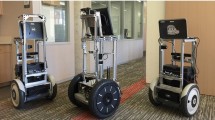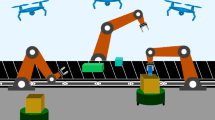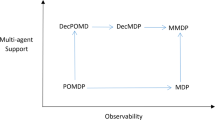Abstract
Many real-world robotic scenarios require performing task planning to decide courses of actions to be executed by (possibly heterogeneous) robots. A classical centralized planning approach has to find a solution inside a search space that contains every possible combination of robots and goals. This leads to inefficient solutions that do not scale well. Multi-Agent Planning (MAP) provides a new way to solve this kind of tasks efficiently. Previous works on MAP have proposed to factorize the problem to decrease the planning effort i.e. dividing the goals among the agents (robots). However, these techniques do not scale when the number of agents and goals grow. Also, in most real world scenarios with big maps, goals might not be reached by every robot so it has a computational cost associated. In this paper we propose a combination of robotics and planning techniques to alleviate and boost the computation of the goal assignment process. We use Actuation Maps (AMs). Given a map, AMs can determine the regions each agent can actuate on. Thus, specific information can be extracted to know which goals can be tackled by each agent, as well as cheaply estimating the cost of using each agent to achieve every goal. Experiments show that when information extracted from AMs is provided to a multi-agent planning algorithm, the goal assignment is significantly faster, speeding-up the planning process considerably. Experiments also show that this approach greatly outperforms classical centralized planning.
Article PDF
Similar content being viewed by others
Explore related subjects
Find the latest articles, discoveries, and news in related topics.Avoid common mistakes on your manuscript.
References
Ambite, J.L., Knoblock, C.A.: Planning by rewriting: Efficiently generating high-quality plans (1997)
Borrajo, D.: Plan sharing for multi-agent planning. In: Nissim, R., Kovacs, D.L., Brafman, R. (eds.) Proceedings of the ICAPS’13 DMAP Workshop, pp 57–65 (2013)
Borrajo, D, Fernández, S: MAPR and CMAP. In: Proceedings of the Competition of Distributed and Multi-Agent Planners (CoDMAP-15). Jerusalem. http://agents.fel.cvut.cz/codmap/results/CoDMAP15-proceedings.pdf (2015)
Borrajo, D., Fernández, S: Efficient approaches for multi-agent planning. KAIS 14, 253–302 (2018)
Borrajo, D, Veloso, M.M.: Probabilistically reusing plans in deterministic planning. In: Inproceedings of ICAPS’12 Workshop on Heuristics and Search for Domain Independent Planning (2012)
Borrajo, D., Roubíčková, A, Serina, I: Progress in case-based planning. ACM Comput Surv 47(2), 35,1–35,39 (2015). https://doi.org/10.1145/2674024
Brafman, R.I., Domshlak, C.: On the complexity of planning for agent teams and its implications for single agent planning. Artif. Intell. 198, 52–71 (2013). https://doi.org/10.1016/j.artint.2012.08.005
Conitzer, V.: Comparing multiagent systems research in combinatorial auctions and voting. AMAI 58(3-4), 239–259 (2010). https://doi.org/10.1007/s10472-010-9205-y
Crosby, M.: Adp an agent decomposition planner. In: Proceedings of the CoDMAP-15, p. 4 (2015)
Crosby, M., Rovatsos, M., Petrick, R.P.: Automated agent decomposition for classical planning. In: ICAPS (2013)
Faigl, J.: Approximate solution of the multiple watchman routes problem with restricted visibility range. IEEE Trans. Neural Netw. 21(10), 1668–79 (2010)
Fikes, R.E., Nilsson, N.J.: Strips: A new approach to the application of theorem proving to problem solving. In: Proceedings of IJCAI, pp. 608–620. http://dl.acm.org/citation.cfm?id=1622876.1622939 (1971)
Foulser, D., Li, M., Yang, Q.: Theory and algorithms for plan merging. Artif. Intell. 57(2-3), 143–181 (1992)
Fox, M., Long, D.: PDDL2.1: An extension to PDDL for expressing temporal planning domains. JAIR 20 (2003)
Fox, M, Gerevini, A, Long, D, Serina, I: Plan stability: replanning versus plan repair. In: Proceedings of ICAPS’06, pp. 212–221 (2006)
Galceran, E., Carreras, M.: A survey on coverage path planning for robotics. Robot. Auton. Syst. 61(12), 1258–1276 (2013)
García-Olaya, A, de la Rosa, T., Borrajo, D.: Using the relaxed plan heuristic to select goals in oversubscription planning problems. In: Lozano, J.A., Gámez, J.A., Moreno, J.A. (eds.) Advances in Artificial Intelligence, pp 183–192 (2011)
Gerkey, B.P., Matarić, M: A formal analysis and taxonomy of task allocation in multi-robot systems. Int. J. Robot. Res. 23(9), 939–954 (2004)
Hoffmann, J., Nebel, B.: The FF planning system: Fast plan generation through heuristic search. JAIR 14, 253–302 (2001)
Howey, R., Long, D., Fox, M.: VAL: Automatic plan validation, continuous effects and mixed initiative planning using PDDL. In: ICTAI 2004, pp. 294–301 (2004)
Janousek, P., Faigl, J.: Speeding up coverage queries in 3D multi-goal path planning. ICRA 1, 5082–5087 (2013). https://doi.org/10.1109/ICRA.2013.6631303
Kavraki, L, Latombe, J.C.: Randomized preprocessing of configuration for fast path planning. In: Proceedings of the International Conference on Robotics and Automation, pp. 2138–2145. IEEE (1994)
Krulwich, B.: Planning for soft goals. In: Hendler, J (ed.) Artificial Intelligence Planning Systems, pp 289–290 (1992). https://www.sciencedirect.com/science/article/pii/B9780080499444500471, https://doi.org/10.1016/B978-0-08-049944-4.50047-1
Luis, N, Borrajo, D: Plan merging by reuse for multi-agent planning. In: Proceedings of the 2nd ICAPS Distributed and Multi-Agent Planning Workshop (DMAP) (2014)
Mali, A.D.: Plan merging & plan reuse as satisfiability. In: Proceedings of the 5th European Conference on Planning: Recent Advances in AI Planning. ECP’99, pp. 84–96 (2000)
Muise, C, Lipovetzky, N, Ramirez, M: MAP-LAPKT: Omnipotent multi-agent planning via compilation to classical planning. In: Competition of Distributed and Multiagent Planners. http://www.haz.ca/papers/muise_CoDMAP15.pdf (2015)
Pereira, T., Veloso, M., Moreira, A.: Multi-robot planning using robot-dependent reachability maps. Springer (2015)
Pereira, T., Veloso, M., Moreira, A.P.: Visibility maps for any-shape robots. In: IROS’16, the IEEE/RSJ International Conference on Intelligent Robots and Systems, vol. 29, pp. 428–459 (2016)
Pereira, T, Luis, N, Moreira, A, Borrajo, D, Veloso, M, Fernandez, S: Heterogeneous multi-agent planning using actuation maps. In: 2018 IEEE International Conference on Autonomous Robot Systems and Competitions (ICARSC), pp. 219–224. https://doi.org/10.1109/ICARSC.2018.8374186 (2018)
Richter, S., Westphal, M.: The LAMA planner: Guiding cost-based anytime planning with landmarks. JAIR 39, 127–177 (2010)
Smith, D.E.: Choosing objectives in over-subscription planning. In: ICAPS (2004)
Štolba, M, Komenda, A, Kovacs, DL (eds.): Proceedings of the Competition of Distributed and Multi-Agent Planners (CoDMAP-15) (2015)
Thakur, D., Likhachev, M., Keller, J., Kumar, V., Dobrokhodov, V., Jones, K., Wurz, J.: Kaminer I (2013) Planning for opportunistic surveillance with multiple robots. In: IEEE/RSJ International Conference on Intelligent Robots and Systems (IROS), pp. 5750–5757. IEEE
Torreño, A, Onaindia, E., Komenda, A., Štolba, M: Cooperative multi-agent planning: A survey. ACM Comput. Surv. 50(6), 84,1–84,32 (2017). https://doi.org/10.1145/3128584
Veloso, M.M., Pérez, M.A., Carbonell, J.G.: Nonlinear planning with parallel resource allocation. In: Proceedings of the DARPA Workshop on Innovative Approaches to Planning, Scheduling, and Control, pp. 207–212. Morgan Kaufmann (1990)
Vidal, V: YAHSP3 and YAHSP3-MT in the 8th international planning competition. In: In 8th International Planning Competition (IPC-2014), pp. 64–65 (2014)
Acknowledgements
This work has been partially funded by FEDER/ Ministerio de Ciencia, Innovación y Universidades - Agencia Estatal de Investigación/TIN2017-88476-C2-2-R and MINECO/TIN2014-55637-C2-1-R. I has been also financed by the ERDF – European Regional Development Fund through the Operational Programme for Competitiveness and Internationalisation - COMPETE 2020 Programme within project < <POCI-01-0145-FEDER-006961> >, and by National Funds through the FCT – Fundação para a Ciência e a Tecnologia (Portuguese Foundation for Science and Technology) as part of project UID/EEA/50014/2013, and FCT grant SFRH/BD/52158/2013 through Carnegie Mellon Portugal Program.
Author information
Authors and Affiliations
Corresponding author
Additional information
Publisher’s Note
Springer Nature remains neutral with regard to jurisdictional claims in published maps and institutional affiliations.
Rights and permissions
Open Access This article is distributed under the terms of the Creative Commons Attribution 4.0 International License (http://creativecommons.org/licenses/by/4.0/), which permits unrestricted use, distribution, and reproduction in any medium, provided you give appropriate credit to the original author(s) and the source, provide a link to the Creative Commons license, and indicate if changes were made.
About this article
Cite this article
Luis, N., Pereira, T., Fernández, S. et al. Using Pre-Computed Knowledge for Goal Allocation in Multi-Agent Planning. J Intell Robot Syst 98, 165–190 (2020). https://doi.org/10.1007/s10846-019-01022-0
Received:
Accepted:
Published:
Issue Date:
DOI: https://doi.org/10.1007/s10846-019-01022-0




